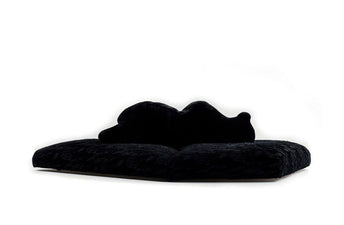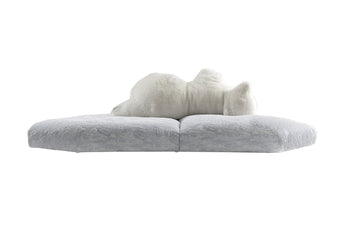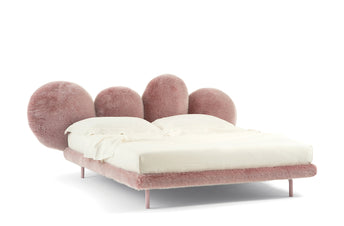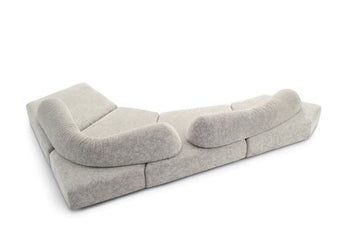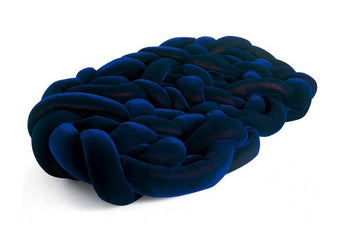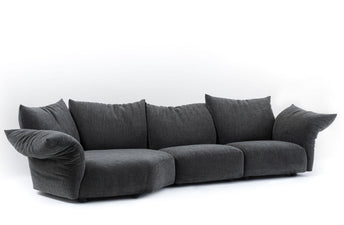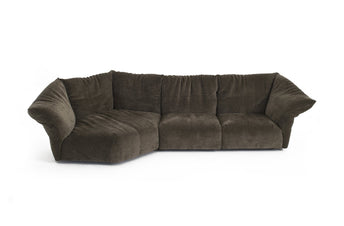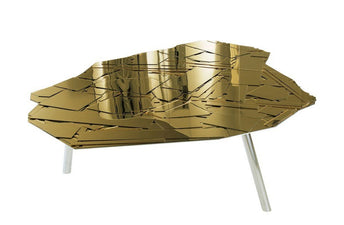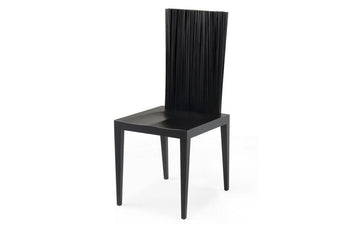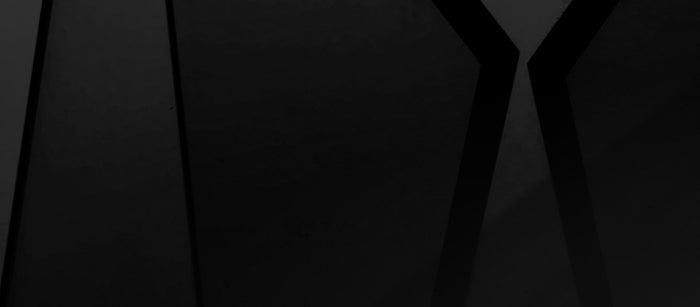
With legendary art director Massimo Morozzi, founders Valerio and Monica Mazzei launched Edra in the final days of the Memphis movement, developing a research hub where designers Francesco Binfaré and Fernando and Humberto Campana helped establish Edra's reputation for art, innovation and a fascination for the avant-garde.
It all began in the hills of Tuscany, a picture-postcard region steeped in culture, art, history, craftsmanship and industrial production way beyond its size, where the Mazzei family has been producing furniture built on craftsmanship since 1949. Edra was born in 1987 as the Memphis Design movement was waning. The avant-garde design group had been the focus of the 1980s design scene since Memphis founder Ettore Sottsass began applying a riot of colour and pattern to some of today’s most collectable furniture icons. Its influence was felt right across popular culture and its ability to make people rethink design – and taste – laid the foundations for what was to follow.
With the legendary art director Massimo Morozzi, the Mazzei family’s second generation, siblings Valerio and Monica Mazzei, applied the experience of the factory to the development of an advanced research hub, combining technical and formal furniture processes – and at the same time coined a new approach ‘High Tech–Hand Made’. Edra and Morozzi, who had co-founded Archizoom in 1966 and was known as one of the 'Italian Radicals’, developed a partnership balancing art and practicality, eccentricity and classical lines. It represented the avant-garde of the Italian design industry in terms of form and typology and shaped the Edra spirit and identity. The group’s interest in exploring, not only craft, materials and technology but also the social changes unfolding, was led by the inquisitive eye of Morozzi. Form over function was never the thinking at Edra, it has always a balance of the two. Just like uncovering and nurturing designers, many working outside the typical industrial model and those not yet discovered, for Morozzi and the team an open approach to the new would become Edra's modus operandi.
'Beauty has always been something to respect, and to respect it we have to give it continuity, not betray it with commercial rules,' explains President Valerio Mazzei from his office in Perignano, Italy, 'The City of Florence, Yves Saint Laurent, art, photography, music… they are the portraits of beauty across the centuries. I like it when someone creates a beautiful object that is also functional because it becomes something that is a pleasure to use. Beauty and functionality, elegance and timelessness must live together.'

The Vermelha is the epitome of the high tech, hand made approach of Edra. The design by Fernando and Humberto Campana is the result of 500 metres of rope carefully woven by hand. Photo c/o Edra.
Other collaborations would include the partnership with Japanese designer Manasori Umeda whose playful designs inspired by nature define the spirit of the late 80s and early 90s. The Getsuen and Rose chairs are now the pin-ups for post-modernism and highly collectable in their own right. The Rose chair was purchased by the National Gallery of Victoria's (NGV) curatorial team for the exhibition Creating The Contemporary Chair. Speaking with Simone LeAmon, Curator of Contemporary Design and Architecture at NGV about the acquisition, the curator remarks: 'There is nothing that makes sense. it’s a parody, a provocation. it says let’s make a chair that’s a big flower...'
As the collection grew with unique pieces, in 2000 the Italian designer Francesco Binfaré would revolutionise what a sofa could do with the launch of Flap. Its design ingenuity establishing the foundations for Edra's collection of innovative sofa systems that now include Binfaré's Essential sofa, Standard sofa and the newest additions to the stable; Pack, On the Rocks and Grande Soffice. 'Francesco is a great producer and designer and we see each other twice a week,' enthuses Mazzei. 'We speak about projects, new requirements, new ways to live in the home. There is a contestant observation of what happens in the world, and from this observation is born the inspiration for projects like Pack.'

The Ella chair designed by Jacopo Foggini for Edra, and in detail following. Photos c/o Edra.

'I like it when someone creates a beautiful object that is also functional because it becomes something that is a pleasure to use. Beauty and functionality, elegance and timelessness must live together.'
Valerio Mazzei, President, Edra
It is this sentiment that highlights the role of a chair as more than just function, it also provides a way to express an idea. In this case it heralded a whole movement against the strictness of modernism. The designers Jacopo Foggini and Peter Traag have also found a home with Edra, producing works that push the capabilities of materials and form, while Edra also produced Zaha Hadid's first furniture project in Italy in the late 1980s.
With an eye for interesting projects and collaborations, in 2011 Edra joined forces with Space Furniture in Australia to launch the inaugural Space+Edra Design Residency The program would provide an important cross-cultural exchange for Australian designer Trent Jansen who was selected from a competitive roll call of local designers to spend two months at the Edra headquarters in Italy working under the wing of Massimo Morozzi. It was the first time Edra had opened the inner workings of their design studio and factories to a young designer in this way, which says everything about the entrepreneurial spirit of the group.
'The residency was profoundly important to me,' remarks Jansen who now teaches and runs a thriving design studio in Sydney. 'First of all, I had an amazing time and learnt a great deal, but my relationships with Massimo and the Mazzei family have also had a significant and lasting affect on my work and my life. Massimo became an important mentor for me before his death, and I visited him on a few occasions after the residency, both to ask for his guidance on projects, and to spend time with him and his wife Cristina. My time at Edra facilitated such amazing professional growth, but most importantly, I consider many of the people at Edra to be close friends. They are exceptional people and I am endlessly grateful for their extreme warmth and generosity.'
'I love the fact that the post-modern era grew out of a provocation and Edra developed a whole story under Massimo Morozzi’s art direction. Edra would be the only manufacturer in the world to do that with such longevity.'
Simone LeAmon, Curator of Contemporary Design and Architecture, NGV

The Pack sofa by Francesco Binfaré for Edra. Photo c/o Edra.
Probably the most high-profile collaboration is Edra's relationship with Fernando and Humberto Campana who first met Morozzi in 1997 and began working with Edra almost immediately. There is a funny story they like to tell of that meeting. Morrozzi fascinated by their work requested information about how they made a particular piece, the Vermelha. Constructed by hand in their São Paulo studio, the only way they could explain the design process was to make a video that showed how they wove the 500 metres of rope to create the chair's form. Not an easy piece to pull off and when the VHS tape was finally finished, it was heavily dubbed with music to cover their arguments.
The vocabulary of the Brazilian designers had found a home with Edra and what has followed is a collection of remarkable pieces that express the beauty of the handmade in tune with the innovative processes of industry. Named by Forbes magazine the 'Masters of Reinvention', highlights from their 20 year partnership would have to be the Favela chair, made from timber scraps left over from the furniture industry, and the Corallo, the Boa and Cipria. Like all of Edra's catalogue, the work is widely collected both privately and by galleries and museums, from MoMA in New York to the Tel Aviv Museum of Art.
With the mantra ‘High Tech–Hand Made’ Edra has found a balance, managing to avoid the 'museumification' of their designs by maintaining the connection to real life. While underpinning it all with research and experimentation. 'Without research we do not make anything,' says Mazzei. 'To give life to concrete thoughts and to projects we need research that often generates something that can be difficult to understand, but ultimately improves our level of knowledge and finds extraordinary application in new products.'
More Space Summer Reading Series – ‘The high tech, hand made world of Edra’ was selected from the More Space archive for the 2022 Summer Reading Series.
Edra is available exclusively from Space – Australia and Space – Singapore and Malaysia.



















